
A rare glimpse in daylight of a House Mouse that, like most mammals, is more often a denizen of the night.
Gardening for Mammals
Considering the close relationships we have with so many mammals – as pets, fluffy toys, cartoon characters – they rarely seem to be high on the wildlife gardener’s target list. That might seem a little strange given that we ourselves are mammals – surely we would want to help any warm-blooded, furry, doe-eyed creature that came our way?
The problem is that many species are either unobtrusive, nervous and nocturnal, or just a bit of a nuisance. There are also rather few species; even a good garden for mammals might only host half a dozen species compared with perhaps 25 bird species. And there is also the problem that the larger mammals tend to occupy such large home territories that one garden can only fulfil a small part of their home needs.

A rare glimpse in daylight of a House Mouse that, like most mammals, is more often a denizen of the night.
But here’s the good news: anyone whose gardens are visited by mammals such as Badgers, Red Squirrels, Hedgehogs or, if you’re very lucky, Dormice or even Pine Martens, will probably get more excited by them than any other wild creature that visits the garden. On top of this, several small mammals are important links in food chains. In short, mammals are definitely worth the effort.
Oh, and understanding all those home needs is indispensable for those times when you want to know how not to encourage a particularly unwelcome guest!

Experiences with creatures such as Hedgehogs can be some of the most rewarding for the wildlife gardener.
Hedgehog
Erinaceus europaeus
This snuffling ball of prickles is an adored and welcome garden visitor that urgently needs our help, having declined from 30 million in the 1950s to less than a million now.
Most people only see Hedgehogs when they have been killed on the roads, but they face many other dangers including less food in the countryside, garden fences making travel through urban areas difficult, and poisoning from slug pellets (especially after eating slugs that have eaten pellets). They are also at risk from bonfires, getting trapped in netting, drowning in steep-sided ponds, and being killed by Badgers and sometimes dogs and Foxes.
HOME NEEDS
Distribution: Thinly spread throughout most of the British Isles.
Habitat: Hedgerows, unimproved grasslands, woodlands and orchards, but also some rural and suburban gardens.
Habits: Nocturnal, they wander for up to 3km a night in search of food using their keen sense of smell and good hearing. They can climb low walls and fences if necessary, but gardens can turn into an energy-sapping assault course. Daytime is spent in one of several ‘nest’ sites in their patch.
Territory: They don’t guard a territory, but individuals stay within home ranges averaging about 10ha for females to 30ha for males. The home ranges of different Hedgehogs will overlap.
Hibernation: November to March, rolled in a ball of leaves under the shelter of log piles, bramble patches, sheds etc. Here the temperature is constant and cool without being cold.
Food: Invertebrates, especially beetles, worms and caterpillars, with some slugs and millipedes, but apparently very few snails or woodlice. They can be opportunistic, even taking carrion.
Supplementary feeding: Dog or cat food (including biscuits) with a shallow bowl of fresh water are ideal. Cows’ milk is too rich and avoid bread, which is hard to digest and low in protein.
Breeding: The female gives birth in a sheltered nest similar to that used for hibernation. She has one or two litters, May–September, with two to five hoglets per litter. They are independent at about eight weeks.
So…
 Ensure your garden is good for worms, beetles and moths.
Ensure your garden is good for worms, beetles and moths.
 Provide small amounts of supplementary food and water.
Provide small amounts of supplementary food and water.
 Create stick piles that have room for a Hedgehog to crawl in underneath, leave leaf piles around the garden in autumn, and build or buy a Hedgehog house.
Create stick piles that have room for a Hedgehog to crawl in underneath, leave leaf piles around the garden in autumn, and build or buy a Hedgehog house.
 Create easy routes in and out of the garden – ideally remove fences and replace with hedges, but at the very least liaise with neighbours to cut ‘passageways’ under fences.
Create easy routes in and out of the garden – ideally remove fences and replace with hedges, but at the very least liaise with neighbours to cut ‘passageways’ under fences.
 Make sure that they can scramble easily out of ponds should they fall in.
Make sure that they can scramble easily out of ponds should they fall in.

Hedgehogs’ well-known defence strategy is to roll into a ball, spines facing out. Unfortunately for them, it is no deterrent to a Badger.
HEDGEHOG HOUSE
 Site in a quiet, sheltered part of the garden. Partly bury in leaves and branches.
Site in a quiet, sheltered part of the garden. Partly bury in leaves and branches.
 An entrance tunnel, about 30cm long, prevents attack by Badgers or Foxes. The tunnel should be about 15cm wide and high, and can be external or (as in the design in the photo) within the box.
An entrance tunnel, about 30cm long, prevents attack by Badgers or Foxes. The tunnel should be about 15cm wide and high, and can be external or (as in the design in the photo) within the box.
 Aim for a main compartment about 30cm high x 30cm deep x 50cm wide. Precision is not required!
Aim for a main compartment about 30cm high x 30cm deep x 50cm wide. Precision is not required!
 Half-fill with dry leaves and hay.
Half-fill with dry leaves and hay.
 Ensure there is good ventilation.
Ensure there is good ventilation.
 Watch the entrance at dusk to see if it is being used rather than being tempted to open it, which can make the occupants abandon home.
Watch the entrance at dusk to see if it is being used rather than being tempted to open it, which can make the occupants abandon home.
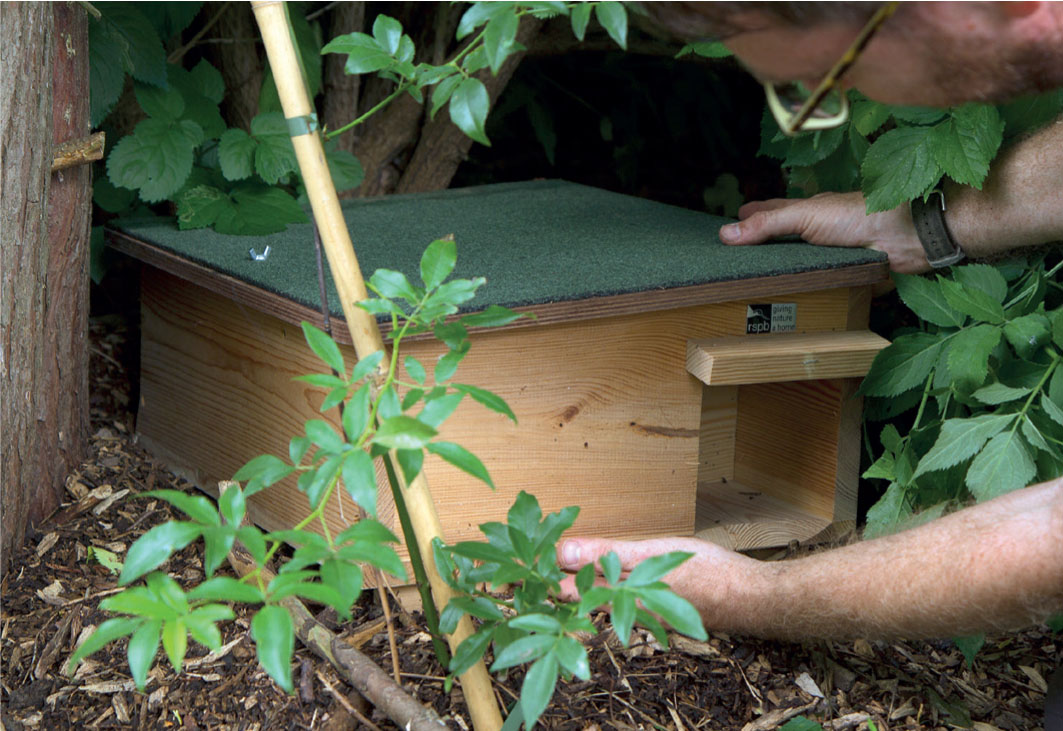
Squirrels
The tale of the two species of squirrel is rather a cautionary one.
The Red Squirrel Sciurus vulgaris is native to Britain and Ireland. It is the Squirrel Nutkin of Beatrix Potter, a bounding high-wire expert of the tree tops with ruddy fur and wispy ear-tufts in winter.
The Grey Squirrel S. carolinensis was introduced into the UK from North America a hundred years ago. It spread rapidly: there are now thought to be over 2.5 million, mainly in England and Wales.
Unfortunately, the Greys brought with them the squirrelpox virus. They are largely immune to it, but Reds are not. Also Greys can digest unripe acorns and nuts, which Reds can’t. And Greys tend to dominate fights with Reds. The result? Wherever Greys turn up, Reds are usually eliminated within 20 years.
Both species damage trees by stripping bark, but it is the Grey that most often enters roof spaces and chews cables, and it redefines what makes a bird feeder ‘indestructible’! Both species also take a few eggs and chicks of nesting birds.
HOME NEEDS
Distribution: Reds are now restricted to the pine forests of Scotland, plus a few places in Ireland, Northumberland, the North West, Wales, the Isle of Wight and Poole Harbour. Greys are found throughout most of England, Wales and Ireland, but are absent from the Isle of Wight, and from most of Scotland bar the central belt. Schemes are underway to try and halt the Grey’s spread.
Habitat: Both species need plenty of large trees, such as in woods, parks and mature gardens. Greys prefer oaks, Beech and Hazel; Reds are most at home in Scots Pine, but in the absence of Greys survive well in deciduous woods.
Habits: Generally solitary, both species are diurnal and spend most of their time high in the branches, leaping from tree to tree along the slimmest of branches. The Grey comes to ground more regularly than the Red. Neither species hibernates.
Food: Reds take the seeds, bark and sap of Scots Pine, plus ripe hazelnuts and beechmast, and fungi. Greys eat hazelnuts, acorns, beech mast and chestnuts, plus cereal grains and fruit. They will raid birds’ nests, and they cache surplus food in autumn, digging small pits in the ground. In gardens, they are particularly fond of peanuts.
Breeding: Both species maintain territories of 2–10ha. They build nests, which are called dreys, high in trees. They are round balls of twigs and pliable stems about 30cm across high in a tree and usually lined with grasses and leaves. Here they sleep and breed. Greys are less skilled at drey building, and will often use a hollow tree. Reds breed twice a year, in early spring and mid–late summer; Greys can breed twice in the same seasons, but often only manage one litter. Reds have 3–8 kittens per litter, Greys 1–7, with the kittens independent at 3–4 months in both species.
So…
 Go in with your eyes open if you want to encourage squirrels – be fully aware of the problems first.
Go in with your eyes open if you want to encourage squirrels – be fully aware of the problems first.
 Don’t provide supplementary food where both Greys and Reds are present – this may help the transmission of squirrelpox. Clean feeders well and often, too.
Don’t provide supplementary food where both Greys and Reds are present – this may help the transmission of squirrelpox. Clean feeders well and often, too.
 If you live in a Red Squirrel area, plant Scots Pine instead of oaks, Beech or Hazel, which will favour the Red.
If you live in a Red Squirrel area, plant Scots Pine instead of oaks, Beech or Hazel, which will favour the Red.
 If you live across a road from prime squirrel habitat, don’t feed them. (I’ll leave you to imagine why!)
If you live across a road from prime squirrel habitat, don’t feed them. (I’ll leave you to imagine why!)
 If Grey Squirrels are getting into your roof spaces, erect a strong wire mesh (25mm mesh or less) over the holes to exclude them, once you are sure there are no adults or babies inside.
If Grey Squirrels are getting into your roof spaces, erect a strong wire mesh (25mm mesh or less) over the holes to exclude them, once you are sure there are no adults or babies inside.
DISCOURAGING GREY SQUIRRELS AT BIRD FEEDERS
Grey Squirrels are masters at getting to bird food, using agility, cunning, determination and brute chewing power in equal measure. To defeat them, view it as a battle of wills and ingenuity where you will sometimes lose. Here are some ideas:
 Hang feeders on a very fine line strung above head height between two trees/stakes; you can even thread empty plastic drinks bottles either side of the feeder as rotating slippery baffles.
Hang feeders on a very fine line strung above head height between two trees/stakes; you can even thread empty plastic drinks bottles either side of the feeder as rotating slippery baffles.
 Put feeders inside a very strong ‘guardian’ cage.
Put feeders inside a very strong ‘guardian’ cage.
 Use anti-squirrel plastic domes above and below pole feeders, and grease the poles with vaseline.
Use anti-squirrel plastic domes above and below pole feeders, and grease the poles with vaseline.
 Turn up the heat! Sprinkle chilli powder or Tabasco on bird food, the stronger the better (but don’t get confused and use curry powder: it won’t work). Squirrels hate it; birds don’t seem to mind.
Turn up the heat! Sprinkle chilli powder or Tabasco on bird food, the stronger the better (but don’t get confused and use curry powder: it won’t work). Squirrels hate it; birds don’t seem to mind.
 I strongly recommend the clever feeders available that use the squirrel’s weight to close access to the food.
I strongly recommend the clever feeders available that use the squirrel’s weight to close access to the food.
 Some people part-solve the problem by giving squirrels their own feeding areas, deflecting them from bird-feeding areas. Just be aware that this may encourage squirrels to stay in and around your garden, putting bird eggs and chicks at greater risk.
Some people part-solve the problem by giving squirrels their own feeding areas, deflecting them from bird-feeding areas. Just be aware that this may encourage squirrels to stay in and around your garden, putting bird eggs and chicks at greater risk.
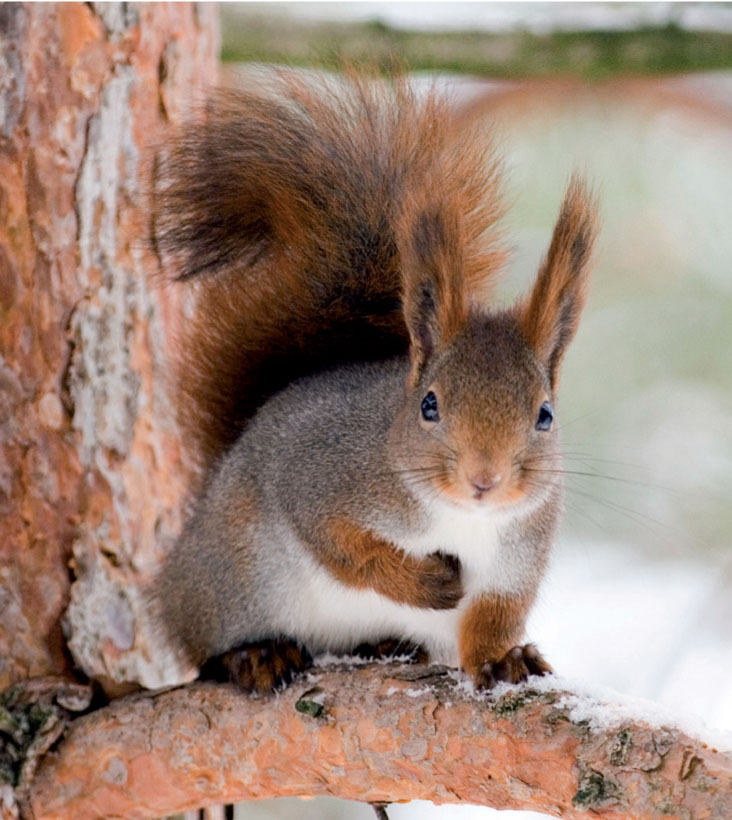
The Red Squirrel is a gorgeous deep auburn, with silver hints. Some Greys can have a reddish tinge in their fur, but never like this!
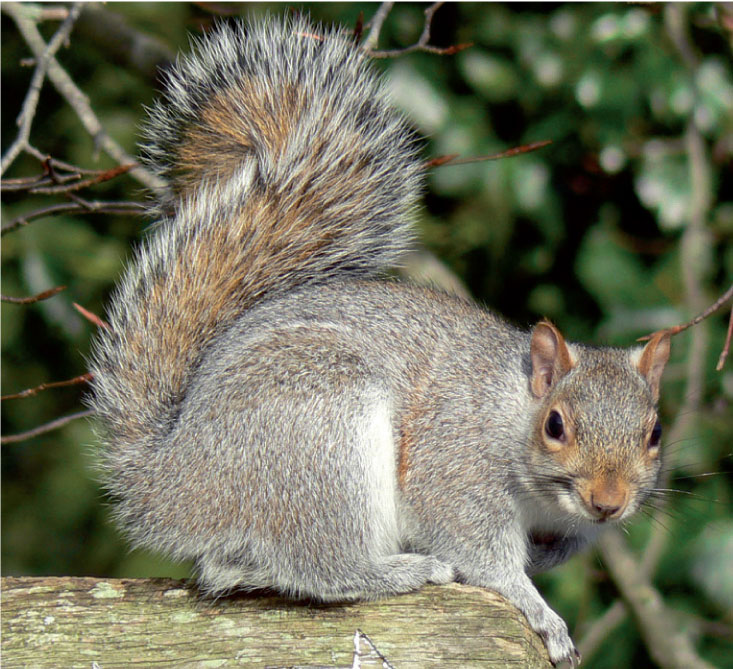
Although they are a problem for the Reds, many people still love Grey Squirrels and no wonder given that they are so approachable and entertaining.

This is the Squirrel Buster bird seed feeder, where the weight of a squirrel causes the strong outer cover to drop down over the seed ports. Yes, ingenuity is an essential ingredient when trying to outwit squirrels.
Hazel Dormouse
Muscardinus avellanarius
Who could resist a golden Dormouse, the little sleepy-head of the animal world? They are rare and elusive visitors to rural gardens near woodland, where any help you can give them is welcome.
HOME NEEDS
Distribution: Widespread but decreasing in southern England with few found further north than the Midlands.
Habitat: Copses, thick hedgerows and coppice woodland, especially with Hazel, Honeysuckle and brambles. They are rare in gardens and don’t come into buildings.
Habits: Usually nocturnal, they scamper through shrubs, rarely coming to ground. Nest-makers extraordinaire, they hibernate for up to six months in winter in a ball of grass, leaves and moss under leaf-litter, while in summer they sleep by day up in a tree in a golf-ball-sized nest woven out of grass and Honeysuckle bark. They happily use Dormice boxes, which are like tit boxes but erected with the hole facing inwards and held clear of the trunk by a couple of batons.
Food: Nuts (especially hazelnuts), seeds, bark, fruit (especially blackberries), flowers (especially of brambles) and insects. A few have started visiting garden bird feeders, even in daylight.
Breeding: Females raise two litters of three to five young in June and August–September in a large nursery nest.
The law: They are fully protected, and you need a licence to handle them or to inspect nest boxes where Dormice are known to be present.
So… If you live next to woodland in the south and have the space, plant a mixed native hedge and lots of Hazel, grow plenty of brambles and Honeysuckle too, and create a ‘coppice rotation’, cutting back a proportion of the trees each year.
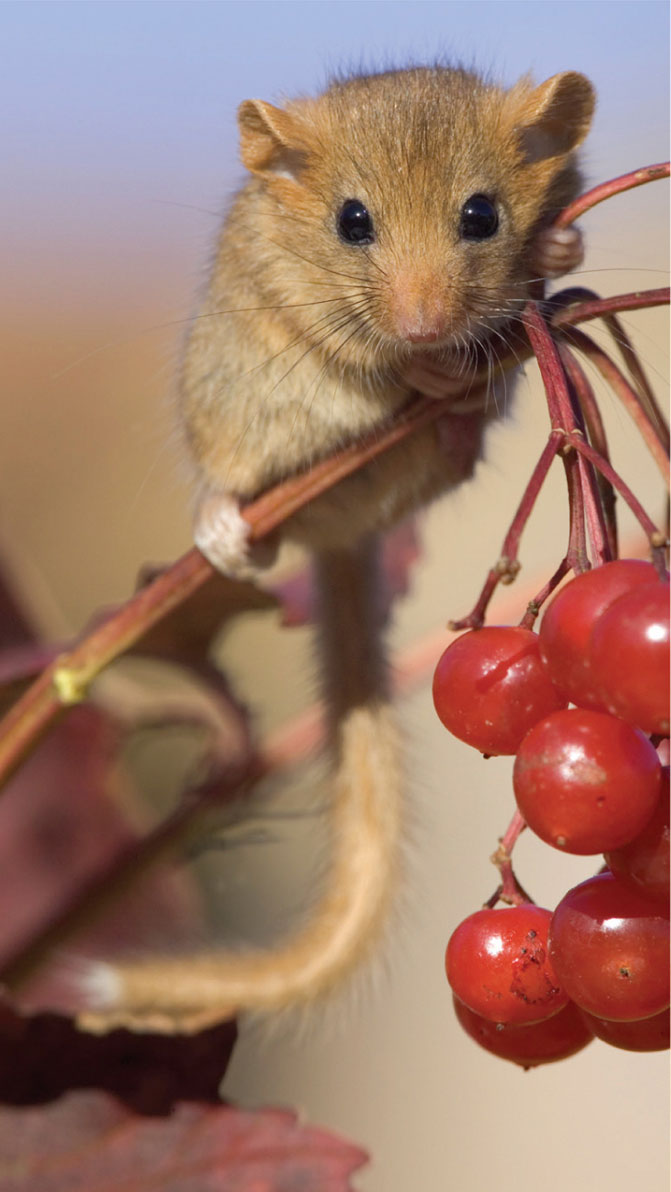
It’s rare to see a Dormouse in daylight, but if you do the wonderful ginger fur and all over cuteness give it away.
Bats
If one group of animals has suffered a poor press going back hundreds of years, it is the bats. It’s what happens when you only come out at night, are a tad on the ugly side and have a tropical cousin that drinks blood. If it wasn’t for Batman giving them a PR lift, they’d be stuck with associations of witchcraft, Dracula and Meatloaf albums.
The reality is that these tiny, vulnerable creatures rarely cause us any problems. They are clean and sociable, and many species have suffered drastic population declines. They even help us, cleansing the night skies of insects, catching them by emitting high squeaks beyond our hearing range and homing in on the tiniest of echoes that bounce back off the insects’ bodies. It’s a skill that guarantees they will never get caught in anyone’s hair, despite popular fears.
There are 17 species of bat breeding in the British Isles, ten have been recorded in Ireland, and the number of species thins out rapidly as you head north. They are very difficult to identify by sight, and you need a licence to observe them at their roosts, so the best way to tell them apart is to use a bat detector, which makes their unique sounds audible to us.
Many species are rare, and some are far more regular around gardens than others. The most frequent visitors are probably Common Pipistrelle Pipistrellus pipstrellus, Soprano Pipistrelle Pipistrellus pygmaeus, Serotine Eptesicus serotinus and Brown Long-eared Bat Plecotus auritus, but there’s always the chance of something rarer, especially in southern rural areas.
Different bat species share many aspects of their lifestyles and behaviour, and there are things that you can do in the garden that will benefit whatever species may be around, so the following is a broad summary of bat needs.
HOME NEEDS
Habitat: Bats can be found almost anywhere in lowland areas, but are mainly associated with woods, hedges, orchards, parks, pond and lake margins, and sometimes cliffs and meadows.
Habits: Bats emerge from their roosts at dusk. They are creatures of habit, most flying along set routes, working one good patch for a while before moving on to the next. They may travel as far as 5km from the roost before returning. They often take rests during the night, clinging to trees or walls while they digest their food. Different species tend to fly slightly differently: the two species of long-eared bat, for example, flutter close to trees, pipistrelles loop and wheel at about head height, while Noctules Nyctalus noctula fly high in straight lines and make steep dives. Bats can live for up to 30 years if lucky. Owls and cats are their principal enemies. Oh, and humans when we undertake house repairs.
Food: All our bats eat night-flying insects, such as non-biting midges, caddis flies, lacewings, beetles, moths and others, and need to eat thousands each night to survive. The two species of long-eared bats are able to snatch caterpillars off leaves. Several species grab insects from the surface of pools, and many will drink this way – batting about is thirsty work.
Hibernation: Bats choose different roosts at different times of year, and their needs are very particular indeed. In winter, they demand somewhere dark, undisturbed, humid and cool, but not cold. Just a few caves, cellars, mines, barns and hollow trees meet these exacting criteria, and few houses are suitable. Inside, they hibernate upside down from November to April. If disturbed, they use up precious amounts of fat and are less likely to survive. They do sometimes emerge briefly during mild spells, however, to hoover up some winter insects.
Breeding: In most species, the males court the females and mate in autumn. In the spring, females gather together in a maternity roost where they will bear their young. Males go somewhere quieter! This is the main time when nest boxes or attics get used by some species. Almost all adult female bats have just one pup a year, in June or July, which will be weaned within about six weeks.
So… To encourage bats:
 Dig a pond. They support heaps of insects, and bats will drink from them, swooping low over ponds soon after dusk.
Dig a pond. They support heaps of insects, and bats will drink from them, swooping low over ponds soon after dusk.
 Grow plants that encourage insects. Your nectar- and pollen-rich flowerbeds will do the trick nicely.
Grow plants that encourage insects. Your nectar- and pollen-rich flowerbeds will do the trick nicely.
 Plant trees. Not only are they great for hosting insects, but they offer sheltered feeding and ultimately may provide roost sites (many years down the line!).
Plant trees. Not only are they great for hosting insects, but they offer sheltered feeding and ultimately may provide roost sites (many years down the line!).
 Don’t nuke insects with pesticides – let nature be the natural pest-controller.
Don’t nuke insects with pesticides – let nature be the natural pest-controller.
 Put up bat boxes.
Put up bat boxes.

Bats are the masters of night-time flight, using echolocation to locate and catch prey, although not always out of the air, as you might have thought.
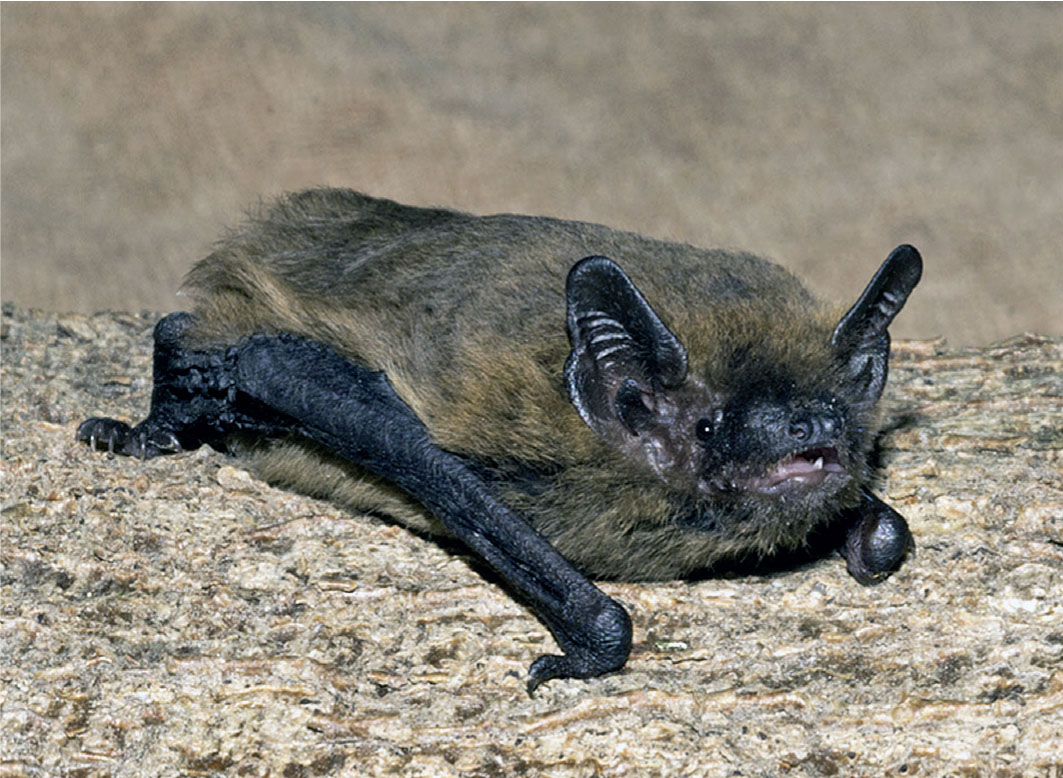
On ‘land’ bats are particularly awkward and vulnerable, barely able to shuffle on flat surfaces and dangling from hooked hind claws on vertical ones.
Bat boxes
Bats are fussy blighters. Unlike Blue Tits, which can move into a new nest box the moment you turn your back, bats can take years to find either the box or the courage. Even then, they may only visit for a few weeks each year when the temperature in that particular box is ‘just so’.
There are several different types of box on the market. It doesn’t matter whether they are box-shaped, wedge-shaped or circular, or whether they are wooden or woodcrete, but the larger the better and there are some definite rules to follow (below). You can make your own, but I have found it very difficult to get hold of untreated timber and it is just as cheap (and much easier!) to buy good-quality ready-made boxes on the market.
The golden rules of bat boxes
When I said they were picky, I wasn’t lying!
Making a good entrance If the entrance is at the rear of the underside of the box, there should be a roughly hewn or grooved backboard beneath it. The bats will land here and crawl in. If the entrance is low down at the front of the box, it should have a little lip to land on but no more. The entrance slit should be no more than 2cm ‘high’; it can be as little as 13mm for pipistrelles.
It’s got to be snug It should be made of wood at least 2.5cm thick, and the joints must be well sealed – bats abhor draughts. A box split internally into vertical cavities offers more space, insulation and microclimates.
No chemicals please Wood must be untreated because bats are very sensitive to chemicals. That doesn’t just mean woodstain – much timber is soaked in preservatives these days.
A bit of rough The wood surface must be rough on the inside – you try hanging upside down on smooth timber!
Location, location, location The box should be at least 3m off the ground on the wall of a house or tree trunk. Place it near a line of trees, but with a clear flightline up to the box. Try to have several boxes in a cluster facing different directions. Unlike bird boxes, some can be in full sunlight, but some cover above is ideal.
To check if your box is being used, look for small, dry, black droppings underneath the box entrance, and watch at dusk to see if anything emerges. If you’re really lucky, you’ll see streams of them.
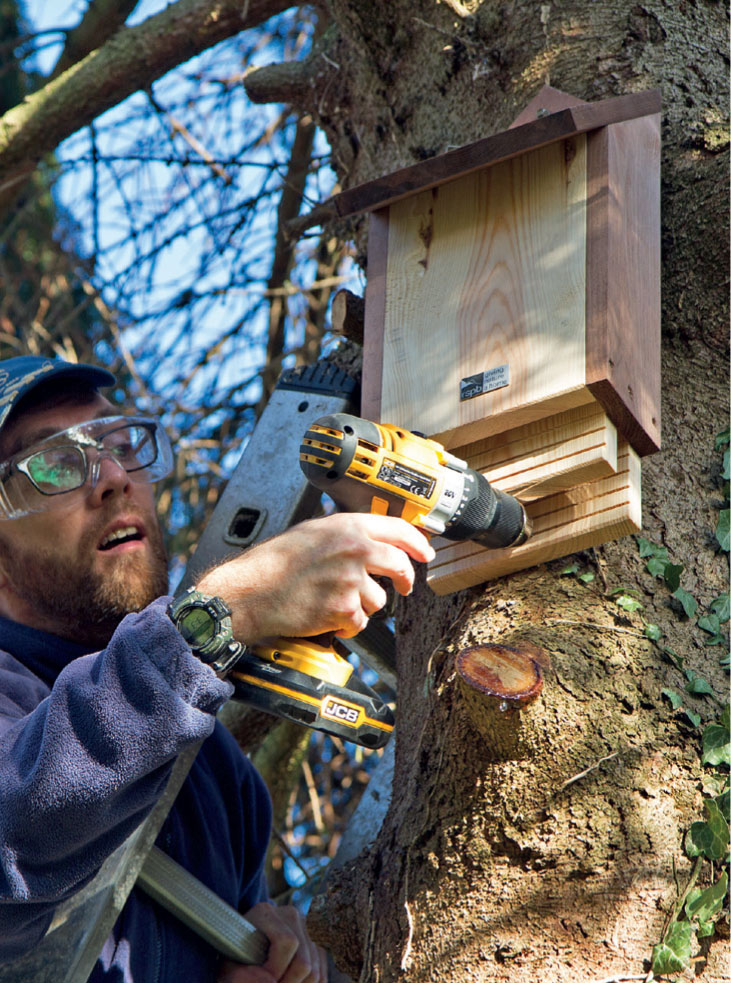
This is a typical bat box, which is about the same dimensions as a Blue Tit box. Bats land on the ‘ladder’ (the grooved backboard at the base) and crawl up through the tiny slit into the box.
Bats and the law
Bats are incredibly well protected – imagine how rare they’d be if they weren’t! It is an offence to kill, injure or capture them, to deliberately disturb them, to handle them without a licence, or to damage, destroy or obstruct access to a known roost whether it is in use or not.
Red Fox
Vulpes vulpes
Isn’t it amazing that a wild dog – and a very attractive one at that – still survives throughout most of western Europe. Even more amazing, it finds a place to call home in the middle of many of our cities.
Be careful when deciding whether to encourage Foxes as they can, on occasion, cause problems. They have been known to attack kittens (although rarely adult cats), and will kill small pets such as rabbits and especially chickens, if poorly housed. They can also dig holes in lawns and flowerbeds when looking for worms, and will root through rubbish bins if the lids aren’t secure, but blame is perhaps too easily placed at their door for some issues.
HOME NEEDS
Distribution: Widespread, found in all but the highest mountains and smaller islands.
Habitat: Once a woodland dweller, they can now be found in almost any habitat and have adapted brilliantly to cities where they are often at their highest densities.
Habits: A pair (dog and vixen) holds territory throughout the year, as little as 20ha in cities but 1,000ha in remote locations. They may share the territory with females from the previous year’s litter, but they usually roam it alone, mainly at night, looking for food. They then lie up by day in thick cover or underground. They mark their territories with scats (dark twisted faeces), pungent urine and secretions from scent glands.
Food: They have an appetite for almost anything – carrion, small mammals, small birds, worms, beetles, fruit (they love blackberries) and kitchen scraps.
Breeding: In January, the top-ranking female in a territory will come into season. During courtship and mating, she will make chilling howls. She chooses a den in which to give birth, called an earth. This can be a hole she digs or finds or even under a shed. A single litter of 1–5 cubs is born in late March–April. The mother will move them if they are disturbed. At 6–9 months, they disperse, and many will breed in their first year.
Threats: Foxes are most at risk from dogs, cars and disease, especially sarcoptic mange. This is a skin mite that causes intense irritation leading to scratching, fur loss and often death.
So… Be careful if planning to put out food for Foxes. It can attract unwanted extra guests such as cats, dogs and rats, and the Foxes can become overly tame and approachable. But if you feel that a little food is justified, try the occasional peanut butter or dog-food sandwich.
DISCOURAGING FOXES
 Don’t overfeed birds, which encourages Foxes to mop up the surplus.
Don’t overfeed birds, which encourages Foxes to mop up the surplus.
 Keep pet rabbits, chickens, etc in secure cages.
Keep pet rabbits, chickens, etc in secure cages.
 Board up gaps under sheds.
Board up gaps under sheds.
 Keep rubbish in closed bins.
Keep rubbish in closed bins.
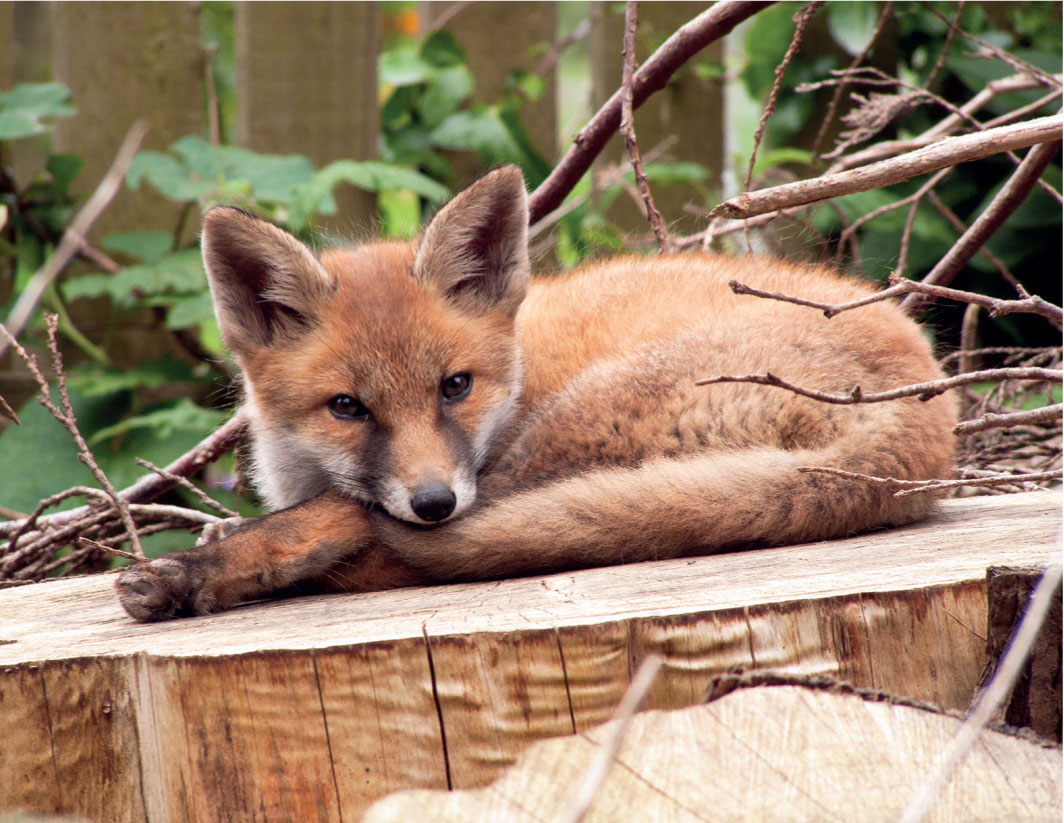
This sunbathing cub was one of a litter raised in a den under a large logpile in my garden. Having resident Foxes is often no problem in a larger garden; most of the time, you wouldn’t know they were there.
Badger
Meles meles
Like the Fox, it is a miracle that a mammal as large as the Badger has survived in our busy world. Elusive, attractive and amusing, watching them can be a real thrill.
However think carefully before encouraging them because these are fruit-chomping master diggers, which can cause problems in gardens. They can raid vegetable and soft fruit crops, dig holes in lawns and damage fences. There is also considerable sensitivity over Badgers because of the risk of them transmitting bovine tuberculosis to cattle, prompting both local culls and calls for more widespread ones.
HOME NEEDS
Distribution: They are found throughout most of the British Isles, but are scarce in upland areas and northern Scotland. They are surprisingly common considering how infrequently they are seen, and they survive well in some urban areas.
Habitat: Usually in deciduous woods, copses and hedgerows near a mosaic of open pasture, arable fields and orchards. They prefer lighter soils, where digging burrows (setts) is so much easier.
Habits: Social groups (clans) of 5–8 adults live in communal setts where they sleep by day. The setts are built into banks and slopes or under tree roots and have several entrances and up to 300m of tunnels leading to various sleeping and breeding chambers. Earth is mounded up outside the entrances, often mixed with spent bedding. Youngsters sometimes use smaller, outlying setts – what you might call sub-setts – to hang out in. The badgers emerge after dark to forage, following regular routes and forming well-worn paths. In winter, they sleep out cold periods, relying on their autumn fat deposits to see them through.
Territory: Rural Badgers have a strict territory, maybe 50ha, marked with latrines. Urban Badgers are rather more chilled and mix more freely.
Food: A forager rather than hunter, earthworms are staple in the diet, but fruit is important in autumn. They also take everything from beetles, slugs, moths and small mammals to bulbs, beech mast, acorns and seeds. They even dig up bee or wasp nests. In gardens, they can raid rubbish bags if given the opportunity, and can cause havoc in carrot crops and soft-fruit beds.
Breeding: Adults (boars and sows) mate in summer with a single litter of 2–3 cubs born in a nesting chamber in February. Cubs stay underground for 6–8 weeks, are weaned at 12 weeks but remain close by their mother into autumn or winter. They live for up to 12 years.
So… If Badgers visit your garden, and you judge there is little risk of conflict with neighbours or farmers, the natural way to encourage them is by letting them access your lawn, where they can find earthworms, and to plant fruit trees, where you can let the windfalls lie where they land. The best supplementary food is ‘wet’ dog food, peanuts, fruit and raisins, but only put out a little – Badgers should not become reliant on it – and ensure it is Badgers that are taking the food, not rats or cats. Don’t feed sugary food or milk.
DISCOURAGING BADGERS
If Badgers are a problem, don’t leave bird food on the ground overnight, secure rubbish bags in closed dustbins and consider using solar-powered electric fencing around your vegetable plot. Excluding Badgers using normal fencing is difficult – those paws were made for digging.

Badgers tend to emerge after dark, following regular routes and forming well-worn paths. Here they forage for food, as opportunists rather than out-and-out hunters.
Stoat Mustela erminea
Weasel Mustela nivalis
These streaks of quicksilver, with their tiny legs and sinuous bodies, are widespread in the countryside throughout most of the British Isles (although the Weasel is absent from Ireland). They live in hedgerows, scrub and unimproved meadows but are rare visitors to gardens.
They need a den snuggled among tree roots or woodpiles and a ready supply of mice and voles; Stoats, being the larger of the two species, also catch rabbits. Weasels are small enough even to fit into rodent burrows.
So… if you have a garden fit for plenty of small rodents, then Stoats and Weasels may follow.
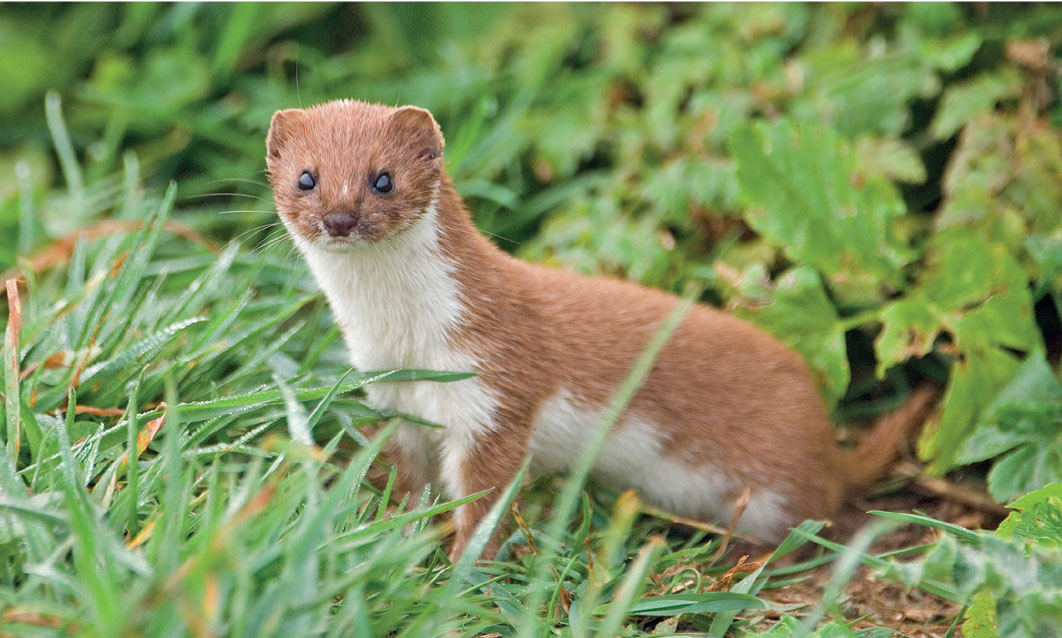
Agile and lithe, both the Weasel (above) and the Stoat have long thin bodies, warm brown above and white below, but only the Stoat has a black tip to its tail.
MICE AND VOLES
Unless you have a prowling cat, you’d probably never realise that mice are commonplace in gardens, and voles sometimes so. Their nocturnal habits and shy nature mean that we rarely see them in the open.
Gardening for them has knock-on benefits: they are prey for owls and Kestrels, while their burrows are prime nesting sites for bumblebees, sometimes even for nesting Coal Tits, and they are used by hibernating lizards and Slow-worms.
Mice
HOME NEEDS
Distribution: Three mice species are commonly found in gardens. The Wood Mouse Apodemus sylvaticus is found throughout the British Isles, the Yellow-necked Mouse A. falvicollis is only found in southern England and Wales, and the House Mouse Mus musculus lives pretty much everywhere.
Habitat: Wood and Yellow-necked Mice are very similar, inhabiting woodlands, hedges and gardens and rarely coming into houses. The House Mouse lives up to its name, much preferring old houses and sheds and only going outside when the weather is warm enough or if it needs to move home.
Habits: Wood and Yellow-necked Mice live fairly blameless lives (as far as we’re concerned) apart from playing merry hell with your sown pea seeds and seedlings. They dig burrows, inside which they create breeding chambers that they line with hay, and larders where they stash food. Above ground, they create a network of little runways through vegetation and leaf-litter. House Mice are more of a nuisance, eating our food, gnawing at wood and cables, and building nests out of loft material, newspapers, etc. They can squeeze through gaps 1cm high, and can run up seemingly smooth internal walls.
Food: Wood and Yellow-necked Mice eat seeds, fruit and berries, plus some insects and small snails. They will readily climb onto bird tables at night. House Mice are pretty omnivorous, especially liking bird food… and your food.
Breeding: All mice can have multiple litters a year, up to ten in the case of the House Mouse.
So… Wood Mice and Yellow-necked Mice are worthwhile visitors for the garden food chain. Give them woodland areas, log piles, dense vegetation and uncut meadows. House Mice are best deterred through good household hygiene and food storage.
Voles
HOME NEEDS
Distribution: The Field (or Short-tailed) Vole Microtus agrestis and the rather russety Bank Vole Clethrionomys glareolus are found throughout most of Britain but not Ireland, while the Common Vole M. arvalis is only found in Guernsey and Orkney.
Habitat: They prefer the dense cover of undisturbed, ungrazed grasslands, hedgerows, scrub and woodlands and some rural gardens, with the Field Vole generally preferring damper habitats.
Habits: Like mice, they too make burrows and have runways, predominantly through long grass. They don’t enter houses, but they can chew the bark of young trees. They don’t hibernate, and suffer losses in harsh weather.
Food: Field and Common Voles eat stems, roots, leaves, bark and the seeds of grasses and sedges, while the Bank Vole also eats berries and fruit.
Breeding: Four to five litters of five to six young, March–November.
So… Turn an area of lawn into meadow, and make a wildlife sunbed nearby, under which they are likely to make neat nests from dried grass and moss.

Bank Voles (above) and Field Voles have small eyes, half-hidden ears, a snub nose and a short tail, unlike mice which have prominent eyes and ears, a long pointed nose and a tail as long as their body.
Shrews
These hyperactive, short-lived, tiny mammals may look mouse-like but are insectivores, related to Hedgehogs. Although rarely seen, you* can hear their high-pitched squeaks as two meet and squabble in the undergrowth (*until about the age of 40!)
There are four species in the British Isles: the Common Shrew Sorex araneus and Pygmy Shrew S. minutus are widespread, although the Common never made it to Ireland, while the Greater and Lesser White-toothed Shrews Crocidura russula and C. suaveolens are found in the Channel Islands, with the latter also on Scilly. The Greater White-toothed has a habit of entering outhouses and even occupied buildings. They are all similar in nature.
HOME NEEDS
Habitat: Rough pasture, hedgerows, dunes, open woodlands, rocky shores and some gardens. Shrews will live in larger and more rural gardens.
Habits: They lead rather solitary lives, scurrying through their small territory along runways hidden in thick grass, or even underground in shallow tunnels. They hunt by day and night, turning over leaves and soil, and taking regular rests in nests. They fall prey to owls, but their musky smell makes them unpopular with mammal predators. They don’t hibernate in winter, when many die.
Food: It’s ‘eat, eat, eat’ all day and all night for shrews. They take insects and their larvae, spiders and woodlice, with the larger species enjoying a few worms.
Breeding: Mainly May–August, raising up to five litters of four to ten young in hollow nests of grass and leaves. Young are independent within eight weeks.
So… Shrews may set up home in your garden if you create areas of meadow and hedgerow, especially if you live near open countryside.

Shrews are easily told from mice by their narrow pink snout, tiny eyes and barely visible ear.
Mole
Talpa europaea
Much despised, Moles can undermine vegetable plots and cause gardeners to tear out their hair. But if the problems they cause in a garden are only aesthetic, hopefully they can be tolerated.
HOME NEEDS
Distribution: Most of Britain but not Ireland.
Habitat: Grasslands, but surprisingly they also live in woods where they are less conspicuous. They come into large gardens near open countryside. Sandy soils are much less favoured.
Habits: They dig their famous tunnel systems close to the surface and extending perhaps 100–200m for each mole. Here they live alone, defending their territories aggressively, although a few tunnels appear to be communal Mole ‘highways’. Moles charge up and down their tunnels looking for food, eating and sleeping in four-hour shifts round-the-clock.
Food: Predominantly worms, but also any other juicy soil creature that drops into the tunnels, which act like pitfall traps.
Breeding: Males go in search of females in early spring. Females raise one litter a year of three to four young in a nesting chamber underground or within an extra-large molehill, lined with dry grass and leaves. The youngsters are then chucked out after five to six weeks and wander above ground through the grass in search of a territory. Many are taken by Tawny Owls at this stage.
So… If you have large grasslands with plenty of soil-life that hasn’t been blasted by pesticides, you may well find that one day a mole appears – or at least a molehill does. If your urge is ‘to get rid’, resist the temptation. It is usually a thankless task. Use the aerated soil heaps as a gift for elsewhere in the garden, rake them thinly over the lawn as a dressing, or better still leave them in place as a fine microhabitat where solitary bees may nest and Robins and thrushes can feed. Go on, be brave!

Molehills are where a Mole has had to extend its tunnels to find food; in areas where feeding is good, you rarely see signs of digging. However, they sometimes come to the surface at night to look for worms.
Deer
If you have a rural garden, especially a large one near to woodland, you have a good chance of being visited at night by deer. If this is the case, you don’t need me to tell you what they’re capable of doing, be it chomping prized trees up to ‘browse height’ or munching choice rose bushes and vegetables. The two most likely species are the elegant Roe Deer Capreolus capreolus and the dog-sized Muntjac Muntiacus reevesi.
HOME NEEDS
Distribution: The Roe Deer was persecuted almost to extinction by the 18th century, but is now doing well across much of rural Britain. The Muntjac was introduced to Woburn Abbey just over 100 years ago, and is increasing across much of southern lowland England and Wales.
Habitat: Both species are animals of dense woodland, conifer as well as deciduous, feeding in rides, glades and adjacent farmland.
Habits: Roe Deer move about singly, in pairs or very small groups, with twin fawns born May–June. The ‘barking deer’, as the Muntjac is sometimes known, lives singly or in pairs. Both hide away by day in woodlands and copses with a thick understorey, and can jump well.
Food: Dawn and dusk are favoured feeding times. Roe Deer browse tree twigs, brambles, roses, Ivy and some grass and flowers, and can destroy trees when they nibble the bark or when the males rub the velvet off their horns against tree trunks (‘fraying’). They will also eat the tips of heathers and young conifers. Muntjac feed on a wide range of succulent ground flora, will nibble at bark and dig up and eat Bluebells. Both move onto autumn-sown cereal crops to feed in winter.
So… A few people tolerate and even enjoy seeing deer in their gardens, but for most the damage they do outweighs the delight. You could try one of the many homespun deterrents, such as human hair and scented soap, but the only guaranteed strategy is a deer-proof fence no lower than 1.5m, and with a mesh no larger than 10cm square. Protect trees with guards, staked at the base.
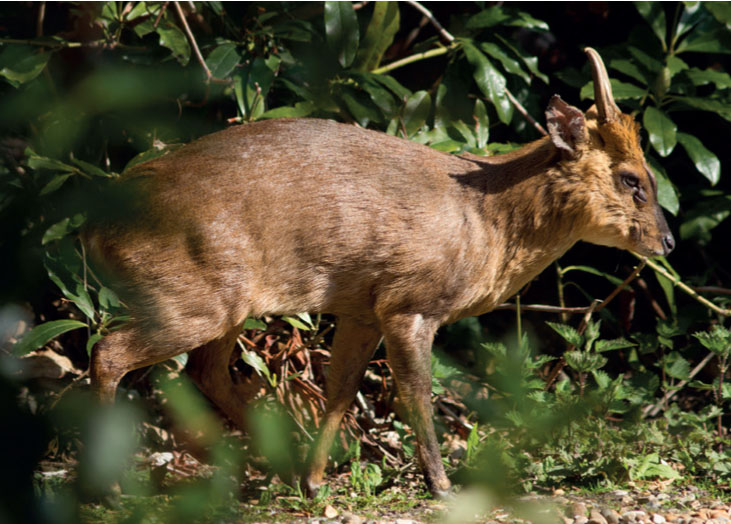
The dog-sized Muntjac – this is a buck I photographed in a Norfolk garden – are perhaps the most regular deer species in British gardens these days.
Rabbit
Oryctolagus cuniculus
They may be cute, but their endless nibbling plus their ability to breed like, erm, rabbits make them considerable pests of agriculture and gardens alike.
HOME NEEDS
Distribution: Native to western mainland Europe, but introduced to the UK in about the 12th century and to many other places in Europe, they are now widespread in the lowlands. The disease myxomatosis was introduced into Britain in the 1950s and wiped out 99 per cent of the population in two years, from which they are slowly recovering (and sometimes relapsing).
Habitat: They are found wherever there are grassy and flower-rich feeding areas near to dense cover, preferring sandy or light soils. Small gardens are often too disturbed.
Habits: Generally sedentary, they live in a social hierarchy of two to three bucks and three to four does plus youngsters. They usually dig a warren of burrows, but sometimes live above ground in dense thickets and between boulders. Most activity is at dawn and dusk.
Food: Vegetarians, but busy ones! One rabbit can eat half a kilo of food a day, mainly grass, wildflowers and cereal crops. In the garden, their love of carrots is no myth, and many other young plants and vegetables are fair game, as is some tree bark.
Breeding: The does have four to six litters, February–July, with two to eight kits per litter. Youngsters are sexually mature at three to four months.
So… If rabbits are raiding your cabbage patch, fencing is the answer. Use a 60cm wire fence, buried 5cm or so under the soil, with a maximum 2.5cm mesh. Trees can be protected with guards.

Undeniably cute, Rabbits are nevertheless usually an alarming sight in gardens, given their capacity to eat almost anything in the flower border!
Brown Rat
Rattus norvegicus
I’m a firm believer that almost all wildlife has a place in the garden – all that is required in some cases is a bit of understanding. However, in the case of rats, the welcome ends. They’re not evil, they don’t mean to cause problems, and remember that their success is entirely down to us. But they’re still rarely welcome!
HOME NEEDS
Distribution: Throughout. Humans brought them as stowaways from Asia in the 18th century.
Habitat: They live in our shadow everywhere – under floorboards, in sewers, in grain stores, in some compost heaps. They also find a home along seaweed-strewn rocky shores and even in hedgerows.
Habits: Quite a social animal, they live in small colonies and often build a good network of underground burrows. They can climb, swim and especially jump, but spend most of the time on the ground, and are most active at night. They seem to be able to gnaw through almost anything and create frequently used runways, marked with greasy smears from their skin glands. They don’t hibernate and are cautious of any new object, making them very difficult to catch. Their urine carries the Weil’s disease (leptospirosis) bacteria, which we can contract causing jaundice and kidney failure.
Food: Originally a grain-eater, they have become a super-scavenger, even existing (apologies if you’re eating) on human faeces.
Breeding: They are prolific breeders, raising three to five litters a year of four to ten young in a nest made of grass, paper, etc. The young leave the nest after three weeks and are sexually mature after three months.
So… Rats probably pass through every garden at some point; your job is to ensure they don’t want to stay. So store bird food securely, only feed birds using rat-proof feeders or only put out enough food in the morning to last the day, and avoid putting meat, dairy or cooked products on compost heaps. If you do all this but still end up with rats, put vegetable peelings and waste fruit in a sealed compost bin, liaise with neighbours in case the problem stems from there, and ultimately be prepared to call in the professionals.
Cats
The number of domestic cats in the UK is astonishing – perhaps as many as 10 million – and although many don’t kill garden birds and other animals, many do. The wildlife body-count is huge.
Although there is no evidence that this causes declines in any species at the wider population level, it can still be very distressing to see cats making a kill, even if it’s your own cat, and there are various things you can do to decrease the number of creatures it brings home.
If you own a wildlife-catching cat:
 Fit it with a bell on a properly fitted collar with a quick-release buckle – it makes stalking in silence difficult and can substantially reduce predation.
Fit it with a bell on a properly fitted collar with a quick-release buckle – it makes stalking in silence difficult and can substantially reduce predation.
 Keep it in from before dusk until after dawn when birds are most vulnerable.
Keep it in from before dusk until after dawn when birds are most vulnerable.
 Have it neutered to prevent additions to the feral-cat population.
Have it neutered to prevent additions to the feral-cat population.
If you don’t own a cat but want to reduce their visits to your garden:
 Buy an electronic cat deterrent. These motion-activated devices can be placed anywhere in the garden and emit a high-pitched noise that cats hate.
Buy an electronic cat deterrent. These motion-activated devices can be placed anywhere in the garden and emit a high-pitched noise that cats hate.
If cats visit your garden regularly:
 Place bird tables and feeders carefully, away from ground cover and preferably high, and use seed trays to prevent food from falling to the ground and tempting birds down to the ground.
Place bird tables and feeders carefully, away from ground cover and preferably high, and use seed trays to prevent food from falling to the ground and tempting birds down to the ground.
 Make sure that you offer wildlife plenty of opportunities to escape from cats, such as dense, thorny bushes and log piles.
Make sure that you offer wildlife plenty of opportunities to escape from cats, such as dense, thorny bushes and log piles.
 Consider using plastic spikes along fence tops, if safe to do so.
Consider using plastic spikes along fence tops, if safe to do so.
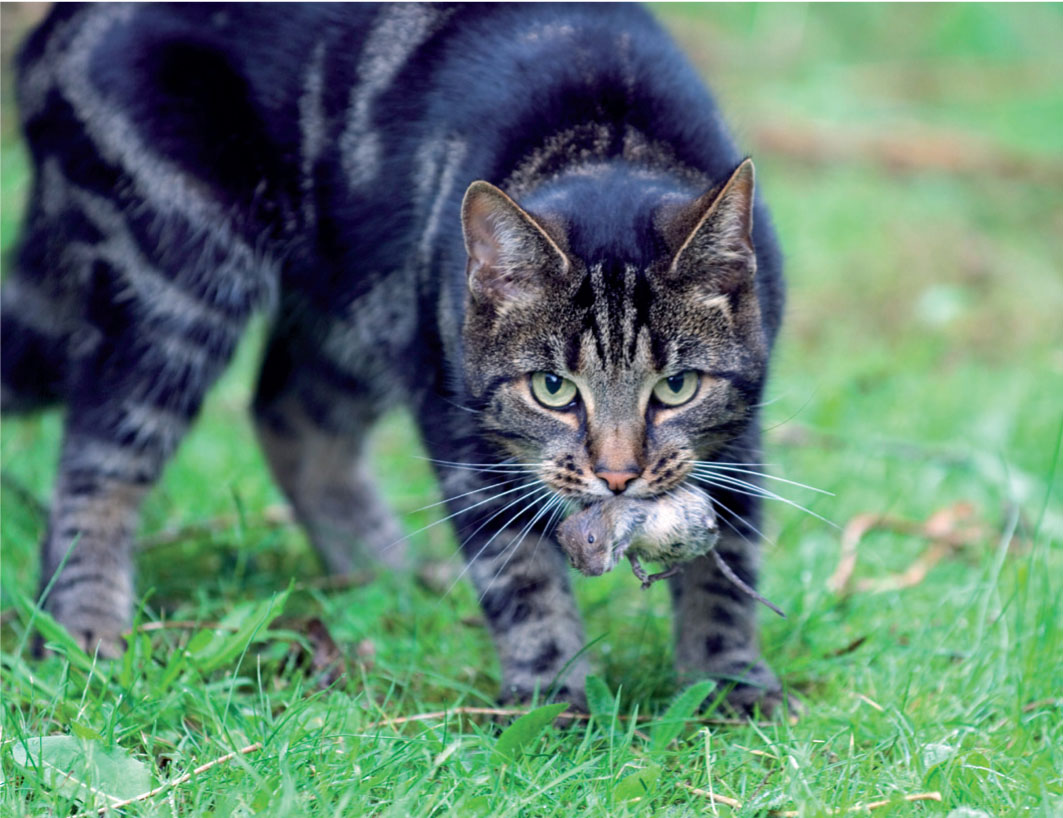
Whereas indoors he is only Tiddles, a loved pet and companion, outside he is loose in the natural world where his hunting instincts can be practiced on rodents, birds, reptiles and amphibians.